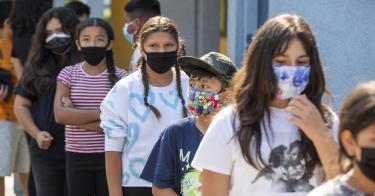As students head back to school, we can check some predictions made last year about how COVID would change K-12 classrooms.
First, teacher unions forecast that schools would close in large numbers without additional federal spending. In June 2020, American Federation of Teachers President Randi Weingarten told Fox News, “We need the money for PPE [personal protective equipment],” and “We need the money for extra teachers; we need the money for extra cleaning and extra buses.”
Washington obliged. Since March 2020, the federal government has committed some $200 billion in COVID relief funds to K-12 schools.
Apparently, the schools didn’t need it. Or if they did, they had a funny way of showing it. According to research from Dan Lips at FREOPP, $180 billion of those funds remain unspent.
>>> New School Year Brings New Education Options for Kids and Families
That’s a point worth emphasizing: Schools around the country opened this month, even in the midst of the uncertainties caused by the Delta variant, and they still have not spent most of the money teacher unions said would be required to get schools running again.
We can safely say this first prediction was wrong.
Second prediction: Public, private, and homeschool operations won’t return to normal anytime soon.
As Heritage Foundation research tracked last year, some of the largest districts in the U.S. saw significant enrollment declines in the 2020-21 school year. Arizona reported that 50,000 students “vanished” last fall, while Massachusetts saw a 4% enrollment decline statewide. New York City officials reported 3% fewer students, and enrollment declines also were documented in Montana, Wisconsin, Missouri, and North Carolina.
While schools were shut, parents created learning pods, and many state legislatures adopted proposals that gave parents and students more options in education. Combine those phenomena with surveys demonstrating that homeschooling is on the rise during the pandemic, it was easy to predict that 2021-2022 was not going to be like the prior school year.
The results of one recent study may be signs of things to come. Enrollment figures from 319 Indiana private schools show that 288 reported increases over the last three years. Nearly half (154) reported increases between the last school year and this one. In some instances, enrollment increases were phenomenal; 49 schools reported increases of at least 150%.
Indiana lawmakers expanded the state’s private school voucher program, which could account for some of the change, but reporter Anthony Kinnett cites parent dissatisfaction with mask policies and curriculum choices as two other reasons parents often gave in explaining their decisions to move to private schools.
A sifting of parents and students into different learning environments continues as the virus persists, and there are unmistakable signals that traditional public school enrollment is trending down. Contrary to the first forecast, this one appears to be coming true.
Finally, learning pods are here to stay, and some predicted this in 2020. Though state leaders in places like Pennsylvania and Maine tried to regulate the pods, parents have proved resilient.
At the beginning of this school year, with positive COVID tests still a concern for educators, parents and lawmakers are turning to pods again—but this time, participants have the benefit of experience.
In New Hampshire, state officials partnered with Prenda, a learning pod company based in Arizona, and are awarding grants to school districts to create learning pods. Two weeks ago, the New Hampshire Department of Education announced that four districts had been awarded grants to launch pods.
>>> Office for Civil Rights Sticks Its Nose Unnecessarily Into School Masks Debate
News reports from New Jersey and Florida say parents are forming pods again this year, while school officials in Arkansas say they are using small group sessions similar to learning pods in classrooms to start the year.
One new prediction for 2021-22: Parents will not wait to make choices about their child’s learning. Districts dithered over reopening plans last year, even as research demonstrated that schools were not COVID super-spreaders. Meanwhile, parents found solutions such as pods to meet their child’s needs.
Some state officials continue to respond to parent preferences by helping them access a different school if a child’s school closes or adopts a COVID policy (read: masks) that parents disagree with. Arizona Gov. Doug Ducey announced such a choice policy on Aug. 17.
It is safe to expect that parents will not wait—because they will not have to wait—for districts to decide if or when to reopen in the face of COVID this fall. They will just leave.
This piece originally appeared in reimaginED




